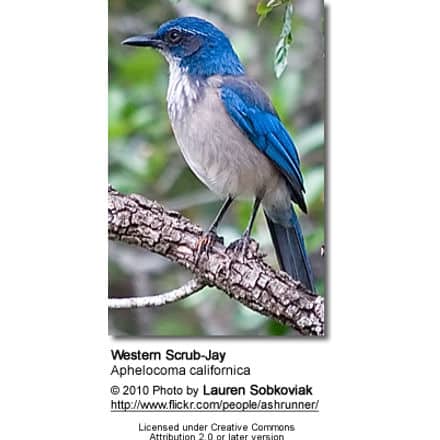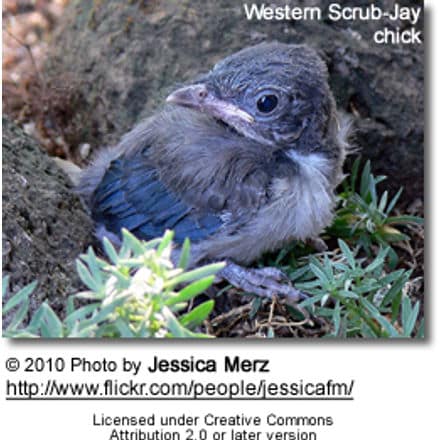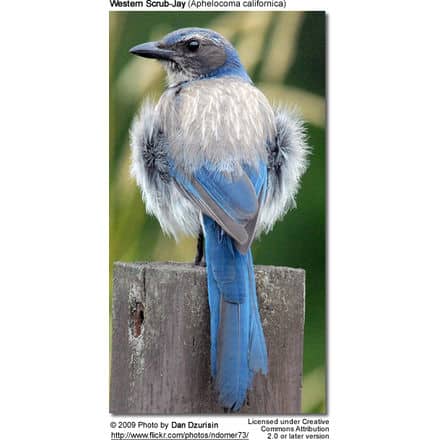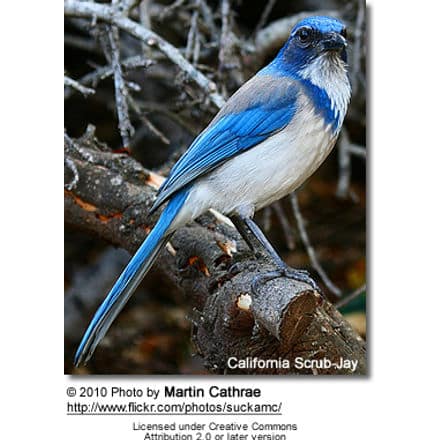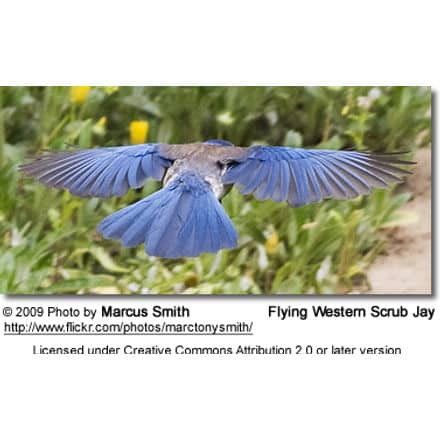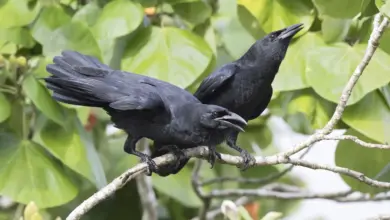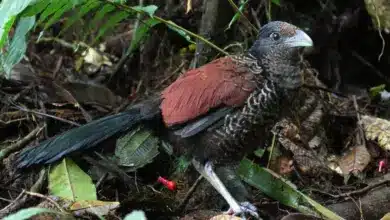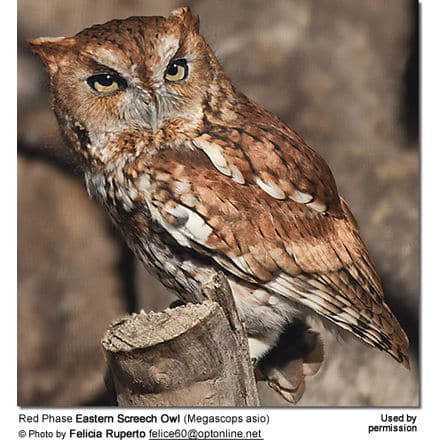Western Scrub-Jays (Aphelocoma californica), also known as Long-tailed Jays
Western Scrub-Jays (Aphelocoma californica), also known as Long-tailed Jays
The Western Scrub-Jays (Aphelocoma californica), also known as Long-tailed Jays, are scrub-jays found in western North America. Their range extends from southern Washington south to central Texas and central Mexico.
These blue-and-grey plumaged birds are sometimes referred to as “Blue Jays” resulting in confusion with the true Blue Jays, which belong to a different family.
Western Scrub-Jays Interesting Facts
The food-caching behavior of these intelligent birds has been the subject of several studies. These birds plan ahead for times when food isn’t readily available. This ability was previously thought to be unique to humans. Scrub Jays bury excess seeds and nuts beneath leaves, grass or mulch; and will retrieve them when food sources in their environment are scarce.
They may also hoard and bury brightly colored objects found in their environment.
According to research, their brain-to-body mass ratio rivals that of chimpanzees and cetaceans (ie. whales and dolphins).
Blue Jay Funerals: The University of California, Davis reported an odd behavior of Western Scru-Jays that is not typically associated with animals. These birds appear to mourn the loss of flock members. These jays will loudly screech near a dead jay for as long as 30 minutes and remain close to the body for a day or two. Similar behavior was reported from the extinct Carolina Conures – who flocked around injured or dead flock members (often wounded or killed by hunters) in a manner that suggested mourning. This predictable behavior made these birds easy targets and contributed to the extinction of that species.
Cooperative relationship with large mammals: Mule deer have been observed allowing scrub jays to hop over their bodies and heads as they search and feed on parasites, such as ticks. The deer appeared to facilitate the process by standing still and holding up their ears to provide easy access to the jays.
Distribution / Habitat
Western Scrub-Jays are resident (non-migratory) within their range, which extends from southwestern Washington to southwestern Wyoming, Colorado, and central Texas south through the southwestern United States to southern Baja California and Oaxaca, Puebla, and west-central Veracruz in Mexico.
Vagrants may occur as far north as southwestern British Columbia in Canada.
They inhabit scrubby woodland and chaparral, favoring pinyon, juniper and oak trees. But they may also occur in mesquite bosques or suburban gardens.
Subspecies, Ranges and ID:
Three distinct groups have been identified:
- California scrub jays found along the coast
- Woodhouse’s Scrub-Jays from the interior US and northern Mexico
- Sumichrast’s Scrub-Jays from interior southern Mexico
Physical Differences:
- Coastal populations have brighter blue upperparts and whiter throats than those found in the interior. Coastal birds also have a strongly defined blue chest band, which is indistinct and typically incomplete in interior birds.
- The members of the California and Sumichrast’s have strong bills that are hooked at the tip, which are well adapted for feeding on acorns.
- The members of the Woodhouse group have slimmer, longer and straighter bills with little or no hook.
California Scrub-Jays – “Nominate Group
California Jay or Western Scrub-Jays (California) (Aphelocoma californica californica – Vigors, 1839)
Range: Central California Coast from San Mateo County and southeastern Alameda County south to southwestern Ventura County. Recently have expanded their range north into the Puget Sound region of Washington.
Interior Scrub-Jay, Long-tailed Jay, Long-tailed Scrub-Jay or Western Scrub-Jay (Long-tailed) (Aphelocoma californica californica [immanis] – Grinnell, 1901)
Range: Northwestern USA – from western Washington (Puget Sound) south to coastal and interior western Oregon (Willamette Valley)
ID: Large subspecies with well-defined breast bands. Mostly feeds on acorns.
Western Scrub-Jay (caurina) (Aphelocoma californica californica [caurina] – Pitelka, 1951)
Range: Coastal southwestern Oregon south to central California (Napa and Sonoma Counties) and east to inner California Coast Ranges
Nicasio Jay, Nicasio Scrub-Jay, Western Scrub-Jay (Nicasio) (Aphelocoma californica californica [oocleptica] – Swarth, 1918)
Range: South-central Oregon south to interior central California (to include Sacramento and San Joaquin Valleys and adjacent Coast Ranges south to the San Francisco peninsula), Sierra Nevada foothills, and east to western Nevada
- Belding’s Jay, Belding’s Scrub-Jay, Western Scrub-Jay (Belding’s) (Aphelocoma californica obscura – Anthony, 1889)
- Range: Southwestern California (highlands of Mojave Desert and Whale Peak in San Diego County) and extreme northwestern Mexico (northern Baja California – south to Todos Santos Bay)
- ID: Smaller and darker plumaged than nominate form
- Xantus’s Scrub-Jay, Western Scrub-Jay (Xantus’s) (Aphelocoma californica hypoleuca – Ridgway, 1887)
- Range: Northwestern Mexico from the arid regions of central and southern Baja California south of a line through Bahía Magdalena, Sierra de Calamajué, and Loreto, Baja California Sur
- ID: Smaller and slightly paler than nominate form; longest bill of any member in this group
- Western Scrub-Jay (Desert) (Aphelocoma californica hypoleuca [cactophila] – Huey, 1942) – Proposed race
- Range: Northwestern Mexico in central Baja California
- Desert California Jay, Desert Scrub-Jay, Western Scrub-Jay (Desert) (Aphelocoma californica hypoleuca [cactophila])
- Central Baja California
Woodhouseii Group or Woodhouse’s Scrub-Jays
Natural range: Great Basin.
Physical Differences: Grey plumage, less contrasting chest band.
Taxonomy: Sometimes considered a different species.
- Woodhouse’s Scrub-Jay (Aphelocoma woodhouseii woodhouseii – Baird, SF, 1858) – Nominate form
- Range: Rocky Mountains foothills, from northern Utah and southern Wyoming south to northern Chihuahua in north-central Mexico and western Texas.
- Eagle Mountain Scrub-Jay, Woodhouse’s Scrub-Jay (Eagle Mountain) (Aphelocoma woodhouseii [cana] – Pitelka, 1951)
- Range: Range limited to the single-leaf Pinyon forests on Eagle Mountain in Joshua Tree National Park in arid southeastern California.
- Great Basin Jay, Great Basin Scrub-Jay, Nevada Scub-Jay, Woodhouse’s Scrub-Jay (Great Basin) (Aphelocoma woodhouseii [nevadae] – Pitelka, 1945)
- Range: Interior western USA – from southeastern Oregon south through the Great Basin, mountains in Death Valley and Mojave Desert, east to southwestern New Mexico and south to northeastern Sonora and northwestern Chihuahua in northern Mexico
- Texan Jay, Texas Jay, Texas Scrub-Jay, Woodhouse’s Scrub-Jay (Texas) (Aphelocoma woodhouseii texana – Ridgway, 1902)
- Range: Edwards Plateau in west-central Texas
- Woodhouse’s Scrub-Jay (grisea) (Aphelocoma woodhouseii grisea – Nelson, 1899)
- Range: Northwestern Mexico, on the eastern slopes of Sierra Madre Occidental, although more concentrated in Chihuahua
- Blue-eared Jay, Blue-eared Scrub-Jay, Woodhouse’s Scrub-Jay (Blue-eared) (Aphelocoma woodhouseii cyanotis – Ridgway, 1887)
- Range: Mountains of east central Mexico – from southern Coahuila and Nuevo León to Hidalgo (lower Sierra Madre Oriental)
Sumichrast’s Scrub-Jays (interior southern Mexico)
- Sumichrast’s Scrub-Jay (Aphelocoma sumichrasti – Ridgway, 1874)
- Range: Highlands of the southern Mexican plateau from the Distrito Federal east to Veracruz, Oaxaca and Isthmus of Tehuantepec
- Chilpancingo Scrub-jay or Sumichrast’s Scrub-Jay (Chilpancingo) (Aphelocoma sumichrasti remota – Griscom, 1934)
- Range: Southern Mexico from southwestern Oaxaca and Central Guerrero. Separated from ssp. sumichrasti by the Rio Balsas valley.
- ID: The largest of all Western Scrub-jays
Description
Size
- Comparative size: Medium-sized birds, two-thirds the size of a crow and slightly smaller than a Steller’s Jay
- Body Length: 10.6–12 in (27–31 cm)
- Average Wingspan: 15 inches (39 cm)
- Weight: 2.5–3.5 oz (70–100 g)
Plumage Details / Adults
- Deep blue head with a darker face
- Deep blue neck, wings, and tail
- Grey-brown back
- Faint white supercilium (“eyebrows”)
- Whitish, streaked throat
- Blue chest band
- Plumage below light grey
Other Physical Details
- Slender body
- Very long tail
- Stout, elongated black bill
- Legs and feet are black
Gender ID
Males and females look alike.
Juvenile Description
- Chicks are all grey with a red crest on their head (similar to a chicken’s comb)
- As they mature, the plumage gradually turns blue (typically in late summer)
Similar Species
The Western Scrub-Jays and the Pinyon Jays are the only larger bluebirds found in the western USA that don’t have a head crest.
- Florida Scrub-Jays: Out of its natural range (found in Florida)
- Pinyon Jays: Shorter tail stockier body shape
- Blue Jays: Blue crest
- Steller’s Jays: Black crest
- Mexican Jays: All-blue back. No collar.
- Western Bluebirds and Lazuli Buntings: Considerably smaller size. Shorter beak, tail and legs.
Diet / Feeding
The diet of the Western Scrub-Jays varies by season.
During the spring and summer, a large part of their diet consists of:
- fruits, insects, spiders, snails, rodents, reptiles, frogs, and the eggs and nestlings of smaller songbirds.
In winter, they switch to:
- juniper and other berries, nuts (favoring acorn and pine nuts), grains, seeds (including grass seeds)
At any time of the year, they may visit bird feeders for sunflower seeds, peanuts, and corn. They can become quite trusting in urban settings and are known to be easily trained to eat treats (such as peanuts) off human hands. They will also feed on fruits and vegetables grown in gardens and fields.
Outside the breeding season, these jays forage in pairs, family groups, or very small flocks. They tend to be aggressive towards other birds and have been known to steal hoarded acorns and other food items from other birds.
These smart birds cache excess food at scattered locations within their territories for retrieval at a later stage (typically at a time when food sources are scarce – such as during the winter). Their accurate and complex memories enable them to recover hidden food resources even after long periods of time.
Breeding / Nesting
Western scrub-jays are typically monogamous but will seek new mates if their previous was lost.
Most nesting occurs between March and July.
The females construct the nest with assistance from the males. The sturdy, basket-shaped nests are made of twigs, dry grasses, and moss; and the interior is lined with rootlets, fine fibers, feather down and mammal hair. The outside dimensions of Scrub-jay nests are about 13 – 23 inches (33- 58 cm). It takes about 10 days to complete a nest.
Nests are built low in trees or bushes as low as 3 feet (0.9 meters) up to 33 feet (10 meters) above the ground. However, most of them are between the range of 6 – 14 feet (1.8 – 4.3 meters) in oak, pinyon-pine or other trees or shrubs. Nests are generally well concealed in foliage, vines, and mistletoe.
The female lays as few as one up to as many as six eggs that vary in color from pale green to pale greyish white with irregular, olive-colored, or reddish-brown spots or markings. Each egg measures about 0.9 – 1.3 inches (2.4 – 3.4 cm) in length and 0.7 – 0.8 inches (1.9 – 2 cm) in width.
The female incubates the eggs for 15 – 17 days. The hatchlings are blind and naked. Both parents feed and protect them. The young fledge (leave the nest) when they are about 17 – 19 days old and they remain with their parents for about five months.
Pairs usually produce one brood a season.
Calls / Vocalizations / Sounds
Their varied vocalizations are can be harsh, nasal cheerps and chattering calls. They are rendered as “jay“, “jree“, “check-check-check.”
Alternate (Global) Names
Chinese: ??? … Czech: sojka západní … Danish: Kratskade … Dutch: Californische Gaai, Westelijke Struikgaai … Finnish: kalifornianpensasnärhi … French: Geai buissonnier … German: Kalifornienhäher … Hungarian: bozótszajkó … Italian: Ghiandaia occidentale … Norwegian: Krattskrike … Polish: modrowronka kalifornijska … Portuguese: Gaio-dos-matos-ocidental … Russian: ?? … Slovak: kapuciarka dubová … Spanish: Chara Californiana … Swedish: Snårskrika
Life Cycle / Longevity
The average lifespan of a Western Scrub-Jays is about 9 years, but some wild birds have lived 15 years or longer. The oldest reported Western Scrub Jay was a captive bird called “Aaron” who was found in Castaic, CA in 1991 and was raised in captivity. Aaron lived 19 years and 8 months.
Other Web Resources
Please Note: The articles or images on this page are the sole property of the authors or photographers. Please contact them directly with respect to any copyright or licensing questions. Thank you.



